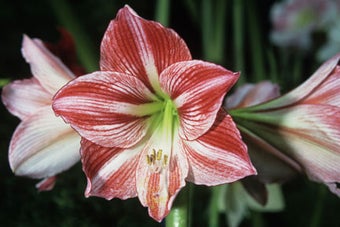
Quick facts
Common name - Tropical hibiscus, rose of China, Hawaiian hibiscus
Botanical name - Hibiscus rosa-sinensis
Group - Evergreen houseplant for warm greenhouse or conservatory
Flowering time - May to October
Planting time - April
Height and spread - May reach 2m (6½ft)
Aspect - Bright, filtered light
Hardiness - Tender minimum 7-10ºC (45-50ºF)
Difficulty - Moderate
Cultivation notes
Hibiscus requires bright, humid conditions with good , protected from direct sunlight and a minimum night temperature of 7ºC (45ºF). Plants can be placed outdoors in summer but need to be brought indoors before temperatures drop below 12ºC (59ºF).
Spring and summer
- Re-pot in February or early March using a peat-free, ideally one formulated specifically for houseplants. Soil based such as John Innes No 2 are also suitable
- Increase watering as the increasing light levels and temperatures stimulate growth
- Begin feeding weekly with a balanced liquid fertilizer for house plants , about six to eight weeks after re-potting
Overwintering
- A warm, humid glasshouse with minimum night temperatures of 7-10ºC (45-50ºF) is ideal, but a warm conservatory or south-facing windowsill will suffice
- Avoid placing plants near open fires, radiators or draughts and move away from windows in frosty weather
- Increase by placing the plant on a tray containing damp gravel or clay pellets. Plants can be grouped together to maintain a humid microclimate
- Reduce watering as growth slows and only water when the top layer of compost is dry. Cease feeding
- In cool conditions plants will overwinter in a semi- condition
Pruning and training
Plants can be kept small and bushy with regular pruning and may live for up to 20 years.
- Shorten the previous season’s growth in February or early March to leave a framework from which new flower-bearing shoots will develop. Stronger growth can be reduced to 4-7 cm (2-3in) from the base
- Remove thin unproductive shoots and prevent overcrowding
- Trim the tips of young plants to encourage bushiness
Propagation
Softwood tip cuttings or semi-ripe cuttings taken in late spring or early summer, root readily;
- Dip 7-10cm (3-4in) long in and insert into trays or pots of sandy cutting
- Ideally use a , although placing pots within plastic bags in warm windowsills can be effective
- Provide bottom heat of 24-27ºC (75-80ºF) and high to encourage rooting in about two weeks
- Pot rooted cuttings in 9cm (3½in) pots and leave undisturbed over winter
Cultivar Selection
Unfortunately houseplants are not reliably listed in the 911���� Plant Finder, as stocks offered in garden centres tend to be sourced abroad making it difficult to identify availablity. Also the range of available Hibiscus rosa-sinensis cultivars is continually changing with new introductions, so it is difficult to make recommendations.
For a form, consider Hibiscus rosa-sinensis ‘Cooperi’ (v) AGM , a compact plant with heavily marbled olive-green and white leaves, sometimes tinted pink and bearing red flowers, height 1-2m (3-6ft)
Problems
Generally trouble free but may suffer from common glasshouse pests such as aphids , red spider mites and glasshouse whitefly .
Flower and leaves turn yellow and drop in winter when light levels are low indoors but plants can survive in this semi- state if watering is reduced.

